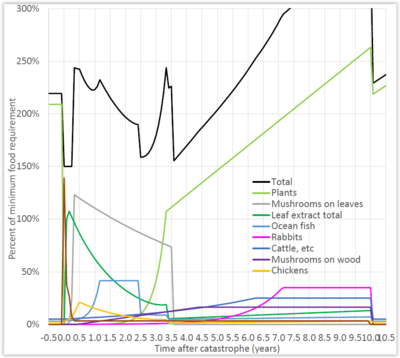J.M.Pearce (talk | contribs) m (→See Also) |
J.M.Pearce (talk | contribs) m (→See Also) |
||
| Line 32: | Line 32: | ||
* [[Cost-Effectiveness of Interventions for Alternate Food to Address Agricultural Catastrophes Globally]] | * [[Cost-Effectiveness of Interventions for Alternate Food to Address Agricultural Catastrophes Globally]] | ||
*[[Cost-effectiveness of interventions for alternate food in the United States to address agricultural catastrophes]] | *[[Cost-effectiveness of interventions for alternate food in the United States to address agricultural catastrophes]] | ||
* [[Food without sun: Price and life-saving potential]] | |||
* [https://sites.google.com/site/daviddenkenberger/publications Dave Denkenberger Publications] | * [https://sites.google.com/site/daviddenkenberger/publications Dave Denkenberger Publications] | ||
* [[Feeding Everyone: Solving the Food Crisis in Event of Global Catastrophes that Kill Crops or Obscure the Sun]] | * [[Feeding Everyone: Solving the Food Crisis in Event of Global Catastrophes that Kill Crops or Obscure the Sun]] | ||
Revision as of 13:23, 20 August 2018
Source
- David C. Denkenberger, D. Dorothea Cole, Mohamed Abdelkhaliq, Michael Griswold, Allen B. Hundley, Joshua M. Pearce. Feeding Everyone if the Sun is Obscured and Industry is Disabled. International Journal of Disaster Risk Reduction 21, (2017), 284–290. DOI: 10.1016/j.ijdrr.2016.12.018 open access

Abstract
A number of catastrophes could block the sun, including asteroid/comet impact, super volcanic eruption, and nuclear war with the burning of cities (nuclear winter). The problem of feeding 7 billion people would arise (the food problem is more severe than other problems associated with these catastrophes). Previous work has shown this is possible converting stored biomass to food if industry is present. A number of risks could destroy electricity globally, including a series of high-altitude electromagnetic pulses (HEMPs) caused by nuclear weapons, an extreme solar storm, and a super computer virus. Since industry depends on electricity, it is likely there would be a collapse of the functioning of industry and machines. Additional previous work has shown that it is technically feasible to feed everyone given the loss of industry without the loss of the sun. It is possible that one of these sun-blocking scenarios could occur near in time to one of these industry-disabling scenarios. This study analyzes food sources in these combined catastrophe scenarios. Food sources include extracting edible calories from killed leaves, growing mushrooms on leaves and dead trees, and feeding the residue to cellulose-digesting animals such as cattle and rabbits. Since the sun is unlikely to be completely blocked, fishing and growing ultraviolet (UV) and cold-tolerant crops in the tropics could be possible. The results of this study show these solutions could enable the feeding of everyone given minimal preparation, and this preparation should be a high priority now.
Keywords
 nuclear war; global catastrophic risk; existential risk; solar storm; electromagnetic pulse; cyber attack
nuclear war; global catastrophic risk; existential risk; solar storm; electromagnetic pulse; cyber attack
See Also
| Feeding Everyone No Matter What |
|---|
Error in widget YouTube: Unable to load template 'wiki:YouTube' |
- Feeding Everyone No Matter What - The full book main page
- David Denkenberger and Joshua Pearce, Feeding Everyone No Matter What: Managing Food Security After Global Catastrophe , 1st Edition, Academic Press, 2015
- Free Preview: Google books
- Cover on Academia
- Facebook page
- Resilience to global food supply catastrophes
- Alternative Foods as a Solution to Global Food Supply Catastrophes
- Cost-Effectiveness of Interventions for Alternate Food to Address Agricultural Catastrophes Globally
- Cost-effectiveness of interventions for alternate food in the United States to address agricultural catastrophes
- Food without sun: Price and life-saving potential
- Dave Denkenberger Publications
- Feeding Everyone: Solving the Food Crisis in Event of Global Catastrophes that Kill Crops or Obscure the Sun
- OSE Wiki "Synfood" (i.e. protein and other dietary components from microbial organisms fed on gas or other hydrocarbons)





